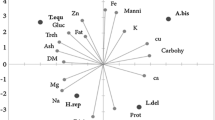Abstract
A comparison of chemical constituents of fresh and conserved samples of Agaricus bisporus was made. The crude protein and crude fat contents were practically unchanged but a decrease in dry matter content and a remarkable decrease in ash content were found. The concentrations of some minerals (Cd, Mn, Zn) were unchanged, indicating that the solubility was not good or the soluble, free forms of element were not present in large amounts. Another group of elements (B, Cu, K, Mg, P, Se) showed a decrease to varying extents because the presence of the free forms of the elements was high. Unfortunately this tendency was with regard to elements that belong to the biologically more valuable mineral components (K, P, Mg). Higher Cr-, Ni-, and Hg-concentrations of conserved mushroom samples are not beneficial characteristics. The extremely high Na level of the conserves (and therefore the changed, unbeneficial K/Na rate) is a hazardous factor to some groups of consumers (patients of high blood pressure and in general people with cardiovascular problems). According to the presented data there are some negative consequences (most of all the changes in minerals) derived from the classical technology of conservation which diminish the nutritional value of the mushroom.
Similar content being viewed by others
References
Lelley J (1991) Pilzanbau. Biotechnologie der Kulturspeisepilze. Verlag Eugen Ulmer, Stuttgart
Rimóczi I, Vetter J (1978) Acta Bot Acad Sci Hung 24:205–218
Vetter J (2000) Magy Gomba 4:5-7
Biekman ES (1996) J Food Eng 29:139–152
Dura S, Tuzel Y (1996) Turk J Agric For 20:207–211
Caglalrlmak N, Ural K, Otles S (2001) Mycol Appl Int 13:97–101
Burton KS, Love ME. Smith JF (1993) Enzyme Microbiol Technol 15:736–741
Vetter J (1993) Z Lebensmittel Unters Forsch 196:224–227
Vetter J. (1989) Int J Mycol Lichenol 4:107–135
Vetter J, Berta E (1997) Z Lebensmittel Unters Forsch 205:316–320
Eisenhut R, Fritz D (1991) Gartenbauwissenschaft 56:266–270
Breene WM (1990) J Food Prot 53:883–894
Senatore F (1992) J Sci Food Agric 58:499–505
Coskuner Y, Özdemir Y (1997) Food Chem 60:559–562
Coskuner Y, Özdemir Y (2000) J Sci Food Agric 80:2074–2076
Acknowledgements
This research was supported by a grant of the Ministry of Education (FKFP 9632).
Author information
Authors and Affiliations
Rights and permissions
About this article
Cite this article
Vetter, J. Chemical composition of fresh and conserved Agaricus bisporus mushroom. Eur Food Res Technol 217, 10–12 (2003). https://doi.org/10.1007/s00217-003-0707-2
Received:
Revised:
Published:
Issue Date:
DOI: https://doi.org/10.1007/s00217-003-0707-2




